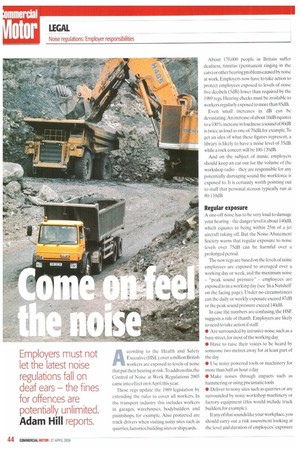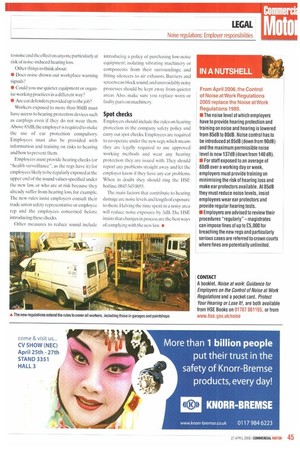Employers must not let the latest noise regulations fall on deaf ears — the fines for offences are
Page 44

Page 45

If you've noticed an error in this article please click here to report it so we can fix it.
potentially unlimited.
Adam Hill reports.
According to the Health and Safety Executive (HSE).over a million British workers are exposed to levels of noise that put their hearing at risk. To address this,the Control of Noise at Work Regulations 2005 came into effect on 6 April this year.
These regs update the 1989 legislation by extending the rules to cover all workers. In the transport industry this includes workers in garages. warehouses, bodybuilders and paintshops, for example. Also protected are truck drivers when visiting noisy sites such as quarries, factories, building sites or shipyards. About 170,000 people in Britain suffer deafness, tinnitus (permanent ringing in the ears) or other hearing problems caused by noise at work. Employers now have to take action to protect employees exposed to levels of noise five decibels (5dB) lower than required by the 1989 regs. Hearing checks must be available to workers regularly exposed to more than 85dB.
Even small increases in dB can he devastating. An increase of about 10dB equates to a 100% increase in loudness:a sound of 80dB is twice as loud as one of 70dB, for exam ple.To get an idea of what these figures represent, a library is likely to have a noise level of 35dB. while a rock concert will be 100-120dB.
And on the subject of music, employers should keep an ear out for the volume of the workshop radio — they are responsible for any potentially damaging sound the workforce is exposed to. It is certainly worth pointing out to staff that personal stereos typically run at 80-110dB.
Regular exposure A one-off noise has to be very loud to damage your hearing — the danger level is about 140dB, which equates to being within 25m of a jet aircraft taking off. But the Noise Abatement Society warns that regular exposure to noise levels over 75dB can he harmful over a prolonged period.
The new regs are based on the levels of noise employees are exposed to averaged over a working day or week, and the maximum noise — "peak sound pressure" — employees are exposed to in a working day (see 'In a Nutshell' on the facing page). Under no circumstances can the daily or weekly exposure exceed 87dB or the peak sound pressure exceed 140dB.
In case the numbers are confusing, the HSE suggests a rule of thumb. Employers are likely to need to take action if staff: • Are surrounded by intrusive noise, such as a busy street, for most of the working day • Have to raise their voices to be heard by someone two metres away for at least part of the day • Use noisy powered tools or machinery for more than half an hour a day • Make noises through impacts such as hammering or using pneumatic tools • Deliver to noisy sites such as quarries or are surrounded by noisy workshop machinery or factory equipment (this would include truck builders, for example).
If any of that sounds like your workplace, you should carry out a risk assessment looking at the level and duration of employees' exposure to noise and the effect on anyone particularly at risk of noise-induced hearing loss. Other things to think about: • Does noise drown out workplace warning signals?
• Could you use quieter equipment or organise working practices in a different way?
• Are ear defenders provided up to the job?
Workers exposed to more than 80dB must have access to hearing protection devices such as earplugs even if they do not wear them. Above 85dB, the employer is required to make the use of ear protection compulsory. Employees must also he provided with intOrmation and training on risks to hearing and how to prevent them.
Employers must provide hearing checks (or "health surveillance", as the regs have it) for employees likely to be regularly exposed at the upper end of the sound values specified under the new law, or who are at risk because they already suffer from hearing loss, for example. The new rules insist employers consult their trade union safety representative or employee rep and the employees concerned before introducing these checks.
Other measures to reduce sound include introducing a policy of purchasing low-noise equipment; isolating vibrating machinery or components from their surroundings., and fitting silencers to air exhausts. Barriers and screens can block sound,and unavoidably noisy processes should be kept away from quieter areas. Also, make sure you replace worn or faulty parts on machinery.
Spot checks Emplt)yers should include the rules on hearing protection in the company safety policy and carry out spot checks. Employees are required to co-operate under the new regs. which means they are legally required to use approved working methods and wear any hearing protection they are issued with. They should report any problems straight away and let the employer know if they have any ear problems, When in doubt they should ring the HSE hotline, 0845 345 0055.
The main factors that contribute to hearing damage are noise levels and length of exposure to them. 1 lalving the time spent in a noisy area will reduce noise exposure by 3dB. The HSE insists that changes in process are the best ways of complying with the new law. M




































































































































































































